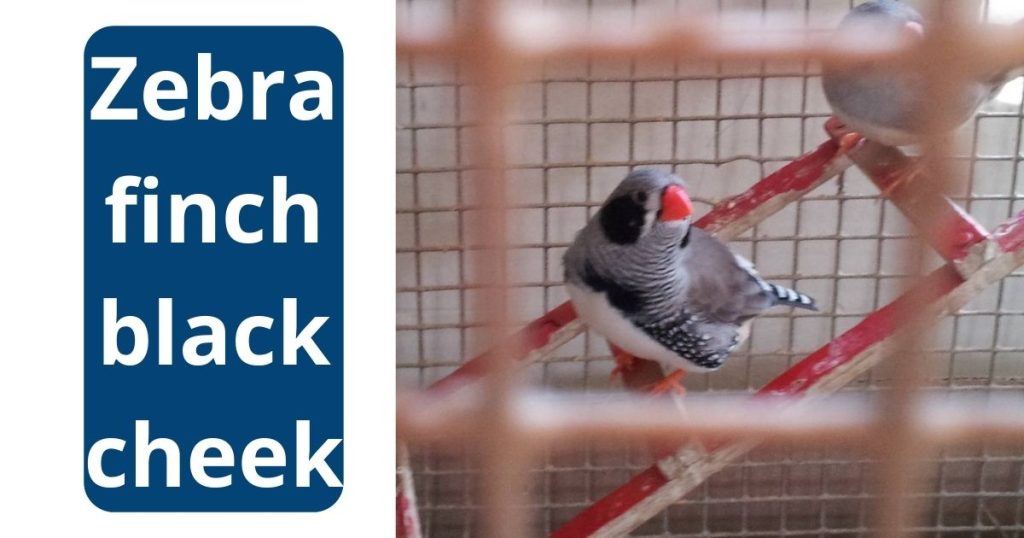Zebra Finch black cheek (Zebra Finch Mutations)

Zebra finches are a popular species that are enjoyed by aviculturists for their unique appearance and social behavior. However, many people do not realize that there are a number of mutations available for this species. One such mutation is the black cheek zebra finch. This recessive mutation allows the birds to have a black face marking that starts behind their beak and ends at their eyes.
Black cheeks
The black cheek serves several functions for zebra finches in the wild. The most important is the visual signal it sends to potential mates during breeding season. Males with more substantial black cheeks are more attractive to females.
The zebra finch is also known for its courtship dance. When a male is ready to breed, he will sing for the female while hopping and fluffing his feathers. He may also bow, crouch, and quiver his tail.
Aside from the black cheek mutation, aviculturists can produce other interesting zebra finch variations. These include Silver Black Cheeks, Fawn Black Cheeks, and Chestnut Flanked White Black Cheeks. The latter variants are especially striking. They are pale bodied birds with vivid glossy black markings on the wings and face.

Mustache markings
During their courtship dances, male zebra finches use songs to attract females. They take bits of music from their relatives and other sounds they hear in their environment to create unique melodies. They also mimic the clucking and whining of other birds.
The zebra finch mustache markings are an indication that a bird is a male. They are found on the cheek patches and throat stripes, while hens lack these markings.
Zebra finches are peaceful birds and can get along with other species of birds in the same cage. They love to fly and need a large cage to exercise their wings. Place multiple perches at different heights in the cage, but not directly over food, water or grit containers. Ensure that the cage has an ample supply of clean, fresh water.

Rusty-orange cheeks
The zebra finch is one of the most common avian species in the world. These beautiful birds are native to Australia, where they live in a dry interior grassland habitat. They can be found in captivity as well, where they have adapted to a variety of living conditions. These birds are highly vocal and can talk all day long when they’re happy.
The black cheek zebra finch is a rare mutation of the zebra finch (Taeniopygia guttata). These birds have more melanin in their feathers, which gives them a darker color. They also have rusty orange cheeks and tails. These birds are often crossed with other zebra finches, producing a wide range of color combinations. These birds can be difficult to breed. However, they are worth the effort.
Black breast bar
In the wild, zebra finches primarily live in arid grassy areas, avoiding wet tropical rainforests and dense woodland. They are easy to breed in captivity and make great companion birds.
These estrildid finches have a fawn body with a black breast bar and chestnut cheek patches. They also have orange blocks on the tail and throat, resembling the striped zebra pattern of their namesake.
Aside from zebra finches, other popular varieties include the penguin zebra finch, orange zebra, and black-cheeked zebra. These finches are a perfect choice for beginners as they are easy to handle and train. They thrive in an environment with plenty of space and a varied diet. They eat a mixture of proso, california wheatgrass, Japanese millet, and canary seed and supplemental foods like grated carrots, boiled egg, kale, and green leaf lettuce.

Social behavior
In the wild, zebra finches live together in large flocks. These groups break down into pairs during breeding season, and each pair defends its territory. Males use songs along with a courtship dance to attract females.
The zebra finch is an ideal study animal for behavioral research. In a recent experiment, researchers found that juvenile male zebra finches prefer their father’s song over the song of a neighbor that they had learned by operant conditioning. This shift in preference occurs at the point where juveniles leave the auditory learning phase and begin singing plastic songs.
In captivity, zebra finches are extremely social and can be trained to sit for treats. They also build domed nests using a wide range of materials, including shredded newspaper, hair, twigs, and spray millet.





